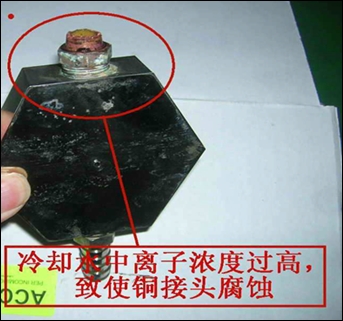- 14
- Apr
Importance de la circulation de l’eau dans le four de fusion des métaux
Importance de la circulation de l’eau dans le four de fusion des métaux
In most metal smelting furnaces, the furnace body and the power cabinet have two independent water systems, an internal circulation system, an external circulation system, internal closed-circuit deionized water, and include a water-to-water heat exchanger, rectification Silicon, reactors, filter capacitors, inverter silicon, and resonance capacitors are all connected to this system. Since the internal water system circulates in the DC high voltage, the internal cooling water will generate electric ions under the action of the pipeline DC high voltage. After a period of time, the concentration of electric ions will gradually increase. When the concentration of electric ions exceeds the required value, the high DC voltage will corrode the copper joints through the cooling water with high concentration of ions, resulting in the situation seen in the photo below. If the water connector corrodes and breaks during use of the power supply, the pressurized cooling water will spray out, causing major equipment accidents, and the cooling water with high concentration of electric ions will reduce the insulation of the system, which is more likely to cause damage to the thyristor Therefore, the conductivity of the cooling water should be checked regularly, and it must be less than 10us/cm. If the conductivity is greater than 100us/cm, replace the circulating cooling water in all power cabinets, and it is recommended to replace it every six months.

Il y a un autre problème dans l’utilisation du refroidissement à eau fermé auquel il faut prêter attention. Le système de refroidissement par eau doit être équipé d’une soupape d’échappement. Cependant, en utilisation réelle, la plupart des systèmes de refroidissement par eau sans soupape d’échappement sont installés. Lorsque le four est hors service pendant une longue période, le gaz pénètre facilement dans le séparateur d’eau. Lorsque le four de fusion des métaux est redémarré, une partie du gaz restera dans le séparateur d’eau et la boîte à eau de refroidissement des composants et ne pourra pas être évacuée, entraînant la défaillance de ce composant. Le refroidissement de l’eau en circulation provoque une température trop élevée pour brûler les composants. Par conséquent, le système de refroidissement par eau sans vanne de vidange n’est pas utilisé pendant une longue période et il est à nouveau activé. La pince à eau au point le plus haut du séparateur d’eau doit être desserrée pour évacuer le gaz restant.
